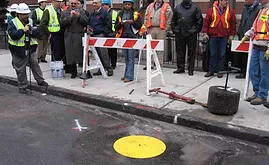
With keyhole techniques, maintenance activities are conducted through small cored pavement openings, resulting in significant cost savings, reduced public inconvenience, and more efficient repairs.
With excavation and restoration expenses costing U.S. natural gas companies more than $1 billion annually, gas system operators are turning to keyhole methods as a way to reduce overall maintenance costs.
Currently, excavation and pavement restoration costs are typically 50% less when keyhole technologies are used. Keyhole technology provides a cost-saving alternative to common repair methods, which often require large “open” excavations, followed by the removal and disposal of unwanted pavements and soils.
These conventional practices – usually performed using several large pieces of equipment (backhoes, dump trucks, pavement breakers) – can account for 80% of the total cost of a repair job.
While utility operations can realize significant savings using keyhole technologies, consumers and the general public also benefit through less disruption and noise, quicker repair times, fewer and shorter service interruptions, and reduced traffic inconveniences.

The process includes a robust, truck mounted coring unit or Minicor coring attachment that quickly and accurately cores up to a 24″ in diameter hole and up to 22″ in depth through asphalt, asphalt-concrete and reinforced concrete road systems and sidewalks.
Keyhole Technology eliminates the need for jackhammers and backhoes, is physically less demanding on work crews, and reduces the cost of these conventional operations by up to 50%
Because the original core, or coupon, is reinserted after the repair, the pavement restoration costs are limited to the labour and materials necessary to reinstate the core permanently – less than $100. No temporary patching or repaving is required. This process results in a permanent repair with cost savings up to 60% or more over current excavation and restoration practice.

The benefits from utilizing keyhole technology are almost too numerous to mention – and applications are growing every year. It is a true win-win-win technology.
Not only is it better for the community in which it is used, it is a better process for those using it, the crew, and perhaps most importantly for the planet on which we all live
It is a green technology that results in a dramatically smaller carbon footprint when compared to traditional construction techniques. It saves tax payers and utility companies millions of dollars when compared to traditional methods of utility patch repair.
Keyhole Applications:
-
Cast iron main joint repair
-
Sacrificial anode installation
-
Installation of new gas services
-
Gas cap replacements
-
Low pressure service cut offs
-
Test holes (pot-holing)
-
Subsurface Utility Engineering
-
Abandoned gas main sectionalizing
-
Water and gas valve box installations
